Have you been having a hard time finding the right guitar bridge? There has long been discussion over whether a bridge should be fixed or floating. What you choose can have a big effect on how you play and how your music sounds.
In this article, Eguitarmania will discuss the main differences between a Fixed Bridge Vs Floating Bridge. We will do a detailed analysis of the pros and cons of each bridge type, comparison, and advice. We’ll also talk about how they can make playing guitar easier or harder, how often you’ll need to tune your guitar, and what they mean by the kind of music you want to play.

What Are Floating Bridges?
The moving bridge, which is also called a tremolo bridge, is an important part of the guitar that affects how it sounds and how easy it is to play. Moving the bridge up and down lets the player change the pitch of the strings. There are different types of moving guitar bridges, but they all work by balancing the strain of the strings. Here are types of floating bridge:
- Vibrato Bridge (Ibanez Edge, Fender Stratocaster)
- Double-locking Tremolo (Floyd Rose)
- Piezo-equipped Tremolo (Fender American Acoustasonic Telecaster)
There is also a tremolo arm, also called a “whammy bar,” built into the bridge. This lets players move the bridge and change the pitch of the strings. Each string has its own saddle, which makes it possible to fine-tune the string height and pitch.
You can change the tension and pitch of the guitar strings by moving the floating bridge. In the 1980s, Fender changed their tremolo to a two-point method to make it work more smoothly.
The block tremolo bridge is still the most important part of trem design. Its “synchronized tremolo” feature lets the bridge saddles and string ends move together, so the movement doesn’t cause the guitar to go out of tune too much.
This feature lets musicians change the sound of single strings or the whole set, which adds to the instrument’s expressiveness. The moving bridge changes the stiffness of the strings, which lets you use methods like vibrato, tremolo, and pitch bends, which are all important for the guitar’s creative potential.
Pros And Cons Of Floating Bridge
Creativity Enhance
Using the tremolo arm, you will have the ability to put some vibrato or even bend entire chords. This encourages experimentation and can lead to unique playing styles and sounds that set artists apart.

Expressiveness at Your Fingertips
Floating bridges’ main appeal is the expressiveness they provide in motion. At the flick of a wrist, players may generate an extensive range of sounds, from delicate vibrations to sonic explosions. Many musical styles, including jazz, rock, and metal, use floating bridges because of the expressiveness they provide.
Tuning Stability Concerns
A potential drawback of floating bridges is that they might be easily tuned wrong. Strings may get out of tune more readily due to the pitch-manipulation balance, particularly when the tremolo bar is used aggressively.
What is a Fixed Bridge?
A hardtail bridge, which is another name for a fixed bridge, is an important part of an electric guitar that holds the strings to the body of the instrument. A floating bridge lets you move and change the pitch, but a fixed bridge stays in one place and provides steadiness and consistent tuning. Here are some variety of fixed bridge:
- Hardtail Bridge (Gibson Tune-o-matic, Fender Stratocaster)
- String-through-body Bridge: Fender Telecaster,ESP/LTD EC-1000
The main job of a fixed bridge is to hold the guitar strings in place at a certain point on the body, giving their vibrations a place to rest. Because it is solidly built and connected to the guitar body, the fixed bridge reduces the chance of string movement and tuning problems. This makes it a great choice for musicians who want stable tuning and easy setup. Also, because a fixed bridge doesn’t have any complicated moving parts, it doesn’t need to be adjusted or maintained as often. This means that players can focus on getting better without having to keep fiddling with the bridge.

A fixed bridge’s ease of use and dependability are two of its best qualities. The tension and pitch of the strings stay the same with this design, which makes tuning more stable than with moving bridges. Also, the fixed bridge is a key part of how the sounds from the strings reach the guitar body, which affects the instrument’s resonance and sound.
The hard link between the strings and the body also gives the sound clarity and accuracy, making it a popular choice for styles that need tight, controlled phrasing.
Pros And Cons Of Fixed Bridge
Impact on Tone and Sustain
The tone and sustain of a guitar can also be changed by the way a fixed bridge is made. It is thought by many players and experts that fixed bridges produce a softer and fuller sound than moving bridges. The direct touch between the bridge and the body of the guitar makes it easier for vibrations to travel, which can improve the guitar’s natural sustain.
Stability and Reliability
Stability is one of the best things about a stable bridge. A bridge system with few moving elements is less likely to break or be out of tune. Since there is no tremolo system, the strings stay at the same tension, which makes tuning problems less likely during shows.
Maintenance and Ease of Use
One big benefit of stable bridges is that they are easy to keep up. Because there are fewer parts, there is less that needs to be fixed, cleaned, or replaced. This ease of use goes to restringing the guitar, which is often a simpler process than on guitars with moving bridges.
Limited Expressiveness
However, the trade-off is a limited expressiveness. Fixed bridges don’t have as many choices for vibrato and pitch changing effects as moving bridges do because they don’t have tremolo systems. This could be a big problem for musicians who use these creative methods to make their sound unique.

Fixed Bridge Vs Floating Bridge For Different Genres
Fixed Bridge:
Best Suited For: Hard rock, heavy metal, and punk rock genres that require solid tuning stability and a focused, high-output tone.
Floating Bridge:
Rock, pop, and some metal genres where expressive tremolo/vibrato playing is desired.
In conclusion, the fixed bridge is more stable when setting and produces a focused, strong tone. The floating bridge, on the other hand, lets you use more dramatic tremolo and vibrato effects but needs more maintenance.
Frequently Asked Questions
Can you change from a fixed bridge to a floating bridge?
It is technically okay to switch from one type of bridge to another. However, let me remind you that it requires a huge change of the design, which can be expensive and could hurt the instrument’s value and purity. Usually, it makes more sense to buy a guitar that already has the bridge type you want.
Which bridge type is better for beginners?
From my point of view, it is easier to use a fixed bridge guitar because of its ease of use, stability, and minimal maintenance requirements. It’s hard to learn how to play the guitar at first, so having a bridge that makes setting up and playing the guitar easier can be very helpful.
Are floating bridges more difficult to maintain than fixed bridges?
Because they have more complicated ways to change the pitch and intonation, floating bridges can be harder to set up and keep up. To play them, the strings and springs in the back of the guitar need to be evenly tense, which can be hard to do. Fixed bridges, on the other hand, are easier to keep and fix because they are designed with fewer parts.
Final Thought
Reflecting on my journey with both fixed and floating bridges, I love both. The tremolo really opens up some cool sounds and techniques. Fixed bridge allows flipping around between different tunings easily and has a different feel.
If I absolutely had to choose one and only one it would be a fixed bridge, because I mess around with different tunings a lot. Tuning a tremolo guitar to drop D for a song or two isn’t practical. Dropping the whole thing a step or two or three just to test something out isn’t even an option with a tremolo.









